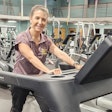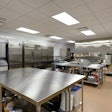Your members and clients are at risk for diminishing bone health as they reach older ages, but there are ways you can help them stay strong.
Many people become concerned about their bone strength when they reach midlife. Peak bone mass is achieved in young adulthood, and begins to decline around the age of 40. At this point, both men and women lose bone mass at a rate of about 0.5 percent per year.2 In the five years following menopause, women lose bone mass at a faster rate, even with a good diet and plenty of physical activity. After these five years, bone loss returns to a slower pace.
Over the years, bone strength may decline to a point where bones fracture easily, leading, in many cases, to continuing disability and a reduced quality of life. Osteoporosis is diagnosed when bone mineral density reaches a critically low level. While many medications are available to help slow bone loss, all have side-effects, and result in only minor gains in bone mineral density. Several lifestyle factors, including regular physical activity and good nutrition, can help slow the rate of bone loss in midlife, and possibly into old age. Therefore, it makes sense for people who are at risk for osteoporosis to be physically active and to consume a healthful diet.
Evaluating bone strength
Bones are composed of several kinds of tissues, including bone marrow, nerves, blood vessels and bone tissue. Bone tissue contains several kinds of cells that regulate bone metabolism, a matrix of mineral salts (primarily calcium and phosphorus) that gives bones their hardness, and a network of collagen fibers that gives bone their strength. Like other living organs, bones are influenced by many factors, including genetics and lifestyle.Unfortunately, researchers do not yet have a good way to measure bone strength in living humans. The most common measurement of bone health is bone mineral density (BMD), measured by a type of X-ray. BMD is usually measured in the spine and hip, important areas to know about in terms of fracture risk.
While BMD is correlated with fracture risk, the amount of mineral deposited in bone is only part of the bone strength story. Bone strength also depends on the structure of the mineral deposits - how they are arranged in the bone tissue. Bone quality is as important as BMD, for it tells you how well a bone behaves in terms of responding to stress. Unfortunately, there are no simple tests for bone quality at the present time.
Making an impact on bone strength
Just as muscle responds to appropriate exercise training by becoming stronger, so does bone tissue. Researchers have evaluated the effect that certain exercise variables have on bone strength. Bone responds to activities that cause physical deformation of bone cells, rather than a high cardiovascular workload. In general, bones respond best to dynamic, weight-bearing exercise that applies relatively high force to bone tissue. What does this mean?Dynamic, in this context, means that the forces placed on bone are moving and changing, vs. stationary and continuous. Running and jumping are examples of activities that apply dynamic forces, whereas wearing a weighted vest during low-intensity daily activity provides more of a static force, as do cross-country skiing, cycling and using an elliptical trainer. Intermittent forces have a greater training effect than continuous activities. Some research suggests that two shorter workouts, with six to eight hours of rest between sessions, provide more bone stimulation than the same minutes of continuous activity.
Weight-bearing means weight is placed on the bones. Walking, running, resistance training and running sports such as soccer, racquet sports and basketball place weight on the bones. Supported activities such as cycling and swimming are less effective for building bone strength.
For bone adaptation, high-intensity exercise means maximizing the mechanical force placed on the bone. Running and jumping activities are good bone builders because they place more force on bone tissue than walking. When a heavier resistance is applied in strength training, bone response is greater.




































